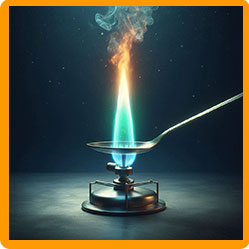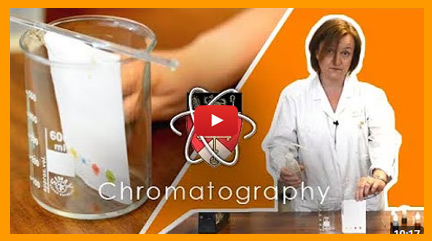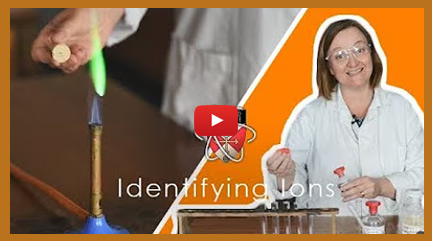
Chemical Analysis
Chemical analysis is the part of chemistry focused on identifying and understanding the substances in a material. It includes both qualitative and quantitative techniques, ranging from simple lab tests to more advanced instrumental methods. This topic is essential for understanding how scientists check the composition, purity, and identity of substances.
Practicals on this page:
Chromatography, Identifying Ions
Pure Substances and Formulations
A pure substance contains only one element or one compound, not mixed with anything else. Pure substances melt and boil at specific temperatures, which makes these properties useful for checking purity. If a sample melts over a range or at the wrong temperature, it's likely impure.
In contrast, many everyday products are mixtures known as formulations. A formulation is a mixture that has been carefully designed for a specific use, made by combining substances in measured quantities. Common examples include paints, fuels, cleaning agents, and medicines. Each component of a formulation has a specific purpose, and changing the proportions can affect how the product works.
Chromatography
Chromatography is a practical method used to separate the different substances in a mixture, often used to identify dyes in inks or colourings in food. In paper chromatography, a small spot of the mixture is placed on a line drawn in pencil on chromatography paper. This paper is then placed in a solvent, such as water or ethanol, with the spot above the level of the solvent.
As the solvent soaks up the paper, it carries the substances in the mixture with it. Different substances move at different speeds depending on how strongly they are attracted to the paper (the stationary phase) and how soluble they are in the solvent (the mobile phase). This causes them to separate into distinct spots.
To help identify the substances, the Rf value (retention factor) can be calculated using the formula:

Comparing Rf values to known reference data can help identify the components in the mixture.
Flame Emission Spectroscopy (Higher Tier Only)
Flame emission spectroscopy is an example of an instrumental method used to identify metal ions and measure their concentration. The sample is placed in a flame, and the metal ions emit light with a specific pattern or spectrum. This emission spectrum is unique to each element, so it can be used to detect which metals are present, even in a mixture.
This method is more accurate, sensitive, and faster than simple flame tests and is commonly used in industry for tasks like detecting trace metals in water or monitoring the purity of products.
Revision Notes

The Cornell method is like a supercharged note-taking system that helps you ace your revision!
Print out our blank revision notes pages to help you revise.
How to make effective revision notes with the Cornell method.
Exam Questions & Answers

Download and print off practice our FREE worksheet with exam style questions on Cell Biology.
Tests for Gases
There are several simple tests used in the lab to identify common gases:
- Hydrogen is tested using a lit splint; if hydrogen is present, it burns with a 'squeaky pop' sound.
- Oxygen is tested with a glowing splint, which will relight if oxygen is present.
- Carbon dioxide is tested by bubbling it through limewater; if present, the limewater turns cloudy.
- Chlorine gas bleaches damp blue litmus paper, turning it white.
These tests are often part of required practical work and are useful in identifying unknown substances.
Tests for Anions (Negative Ions)
To identify anions, several chemical tests are used:
- Carbonates (CO₃²⁻): Add dilute acid. If fizzing occurs, carbon dioxide is being released. This can be confirmed by bubbling the gas through limewater, which turns cloudy if carbon dioxide is present.
- Halides (chloride, bromide, iodide): Add dilute nitric acid followed by silver nitrate solution. The results are:
- Chloride ions give a white precipitate.
- Bromide ions give a cream precipitate.
- Iodide ions give a yellow precipitate.
- Sulfates (SO₄²⁻): Add dilute hydrochloric acid followed by barium chloride solution. A white precipitate of barium sulfate indicates the presence of sulfate ions.
These tests are often used in combination to confirm the identity of an unknown compound.
Tests for Cations (Positive Ions)
There are two main methods for identifying metal cations: flame tests and reactions with sodium hydroxide.
Flame Tests are used to detect certain metal ions based on the colour they produce in a flame. The test involves placing a clean wire loop into the sample and then into a roaring blue Bunsen flame.
- Lithium ions produce a red flame.
- Sodium ions produce a yellow flame.
- Potassium ions produce a lilac flame.
- Calcium ions produce an orange-red flame.
- Copper(II) ions produce a green flame.
Sodium Hydroxide Test: A few drops of sodium hydroxide solution are added to a solution of the metal ion. This may produce a coloured precipitate:
- Copper(II) ions form a blue precipitate.
- Iron(II) ions form a green precipitate.
- Iron(III) ions form a brown precipitate.
- Aluminium, calcium, and magnesium ions all form white precipitates.
To distinguish between them, excess sodium hydroxide is added:
- Aluminium hydroxide dissolves in excess, forming a colourless solution.
- Calcium and magnesium hydroxides do not dissolve, so the white precipitate remains.
Also see Rates of Chemical Change, Energy Changes, Electrolysis
PRACTICAL - Chromatography
Paper chromatography is used to separate and identify substances in a mixture, such as dyes in ink.
In this practical, a small spot of ink is placed on a pencil line near the bottom of a piece of chromatography paper. The paper is then suspended in a solvent (like water), with the ink spot above the solvent level. As the solvent travels up the paper, it carries the different dyes at different rates, separating them into a pattern of spots.
This technique can be used to:
- Identify unknown substances by comparing to known samples.
- Calculate the Rf value of each spot:

PRACTICAL - Identifying Ions
This practical helps you identify unknown ions using a series of chemical tests.
Cation Tests (Positive Ions):
- Flame Tests – Different metal ions produce different flame colours (e.g., lithium = red, sodium = yellow).
- Sodium Hydroxide Test – Add NaOH to metal ion solutions:
- Copper(II) = blue precipitate
- Iron(II) = green precipitate
- Iron(III) = brown precipitate
- Aluminium = white precipitate (dissolves in excess NaOH)
- Calcium and magnesium = white precipitate (insoluble in excess)
Anion Tests (Negative Ions):
- Carbonates – Add acid; fizzing shows CO₂ (test with limewater).
- Halides – Add nitric acid then silver nitrate:
- Chloride = white precipitate
- Bromide = cream
- Iodide = yellow
- Sulfates – Add hydrochloric acid then barium chloride → white precipitate if sulfate is present.
Revision Notes

The Cornell method is like a supercharged note-taking system that helps you ace your revision!
Print out our blank revision notes pages to help you revise.
How to make effective revision notes with the Cornell method.
Why Do I Need to Know About Chemical Analysis?
In Everyday Life
- Making sure the food and drink you consume is safe and contains what it says on the label
- Checking water quality to ensure it’s safe to drink
- Confirming the purity of medicines and the correct dosage in healthcare
- Ensuring cosmetics and cleaning products are made with safe, accurate formulas
- Detecting drug use in sports or the workplace
- Helping police solve crimes using forensic tests
In Science & Chemistry Careers
- Identifying unknown substances using tests like flame tests, gas tests, or chromatography
- Monitoring pollution levels in air, water, and soil
- Developing and testing new medicines or chemical compounds
- Carrying out quality control in manufacturing and production
- Using flame emission spectroscopy and other advanced methods in labs
- Ensuring chemical formulations are consistent and effective in industries like pharmaceuticals, agriculture, and materials science




